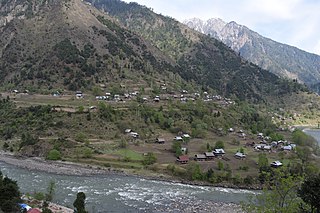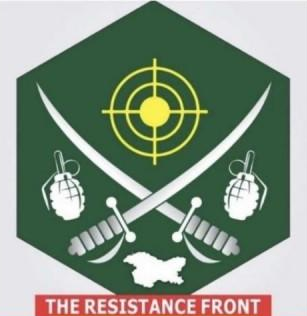
Gulmarg, known as Gulmarag in Kashmiri, is a town, hill station, tourist destination, skiing destination, and a notified area committee in the Baramulla district in the Indian union territory of Jammu and Kashmir. It is located at a distance of 31 km (19 mi) from Baramulla and 49 km (30 mi) from Srinagar. The town is situated in the Pir Panjal Range in the Western Himalayas and lies within the boundaries of Gulmarg Wildlife Sanctuary.
Bandipore or Bandipora is the headquarters of district of Bandipore in the union territory of Jammu and Kashmir, India. It is located on the northern banks of Wullar Lake—the second-largest freshwater lake in Asia. Bandipora has a terraced garden similar to that of Nishat Bagh in Srinagar. Bandipora is bound by mountains on three sides and by Wular Lake on the fourth. As per folklore, the name of Bandipora originated either from Bund of Wular as Bund e pur, from the local folk-singing bands (bāṇd) as Baand e pur or from the enclosed (band) geographical location as Bandh e pur.

Kupwara district is an administrative district of Indian-administered Jammu and Kashmir in the disputed Kashmir region. It is one of the 10 districts located in the Kashmir Valley Division of Indian administered Kashmir. The Pohru River and Mawar river are two main rivers in the district. Both of them meet Jhelum river in Baramulla district.

Jammu and Kashmir is home to several valleys such as the Kashmir Valley, Chenab Valley, Sindh Valley and Lidder Valley. Some major tourist attractions in Jammu and Kashmir are Srinagar, with its renowned Dal Lake and Mughal Gardens, Gulmarg, Pahalgam, Bhaderwah, Patnitop and Jammu. Every year, thousands of Hindu pilgrims visit holy shrines of Vaishno Devi and Amarnath which has had a significant impact on the state's economy.
Baramulla Lok Sabha constituency is one of the five Lok Sabha (parliamentary) constituencies in Jammu and Kashmir in northern India. Baramulla has 11.5 lakh voters.

Bandipore district is an administrative district of Indian-administered Jammu and Kashmir in the disputed Kashmir region. It is one of the 20 districts in the Jammu and Kashmir. Bandipore town is the administrative headquarters of the district. Bandipore is located in the foothills of the snow-clad peaks of Harmukh overlooking the shores of Wular Lake and has produced hundreds of scholars and intellectuals. The district is known for its tourist places such as Wular Vintage Park, Athwatoo and Gurez valley. Before 1947, this town was a big trade and literary centre of Kashmir. This district was carved out from the erstwhile Baramulla district in 2007. The district is bounded by Kupwara district from the north, Baramulla district from west and Kargil district in Ladakh and Ganderbal district from the east. This district occupies an area of 398 km2. The district has a population of 392,232 as per 2011 census.

Keran is a tehsil in Kupwara district, Jammu and Kashmir, India. It is on the bank of the Kishanganga River. The village lies on the Line of Control. The Keran block includes four panchayats: Keran, Mandian, Mandian-A and Kundian Pathroo.

Gurez, or Gurais, is a valley located in the high Himalayas, about 86 kilometres (53 mi) from Bandipore and 123 kilometres (76 mi) from Srinagar, to the north of the Kashmir valley. At about 2,400 metres (8,000 ft) above sea level, the valley is surrounded by snow-capped mountains. It has diverse fauna and wildlife including the Himalayan brown bear and the snow leopard. The Kishanganga River flows through the valley.

Indian cold wave during the winter months of 2012 killed at least 92 people across northern and eastern India. The drop in temperature had a devastating effect on the hundreds of thousands of homeless people in India.
2017 in India highlights the national/Daily level events during the year.
The Gurez Avalanche Accident was a series of four avalanches that claimed the lives of 24 persons, including 20 soldiers and four civilians in Jammu and Kashmir on the evening of 25 January 2017.

Indian Army operations in Jammu and Kashmir include security operations such as Operation Rakshak, which began in 1990, Operation Sarp Vinash in 2003 and Operation Randori Behak in 2020. Other operations include humanitarian missions such as Operation Megh Rahat and operations with a social aim such as Operation Goodwill and Operation Calm Down. The Indian Army works in tandem with the other arms of the Indian Armed Forces and security forces in Jammu and Kashmir such as during Mission Sahayata or joint operations.

Popular sports in Jammu and Kashmir include cricket, football and winter sports along with sports like golf, water sports, Ice stock sport and adventure sports. The National Winter Games have been held in Gulmarg in 1996, 2004 and 2009. The first Khelo India Winter Games were held in February and March 2020 in Leh and Gulmarg. Jammu and Kashmir won the most gold medals while the Indian Army team came second with 8 gold medals. The second edition of the winter games were also held successfully in Gulmarg in 2020 with Jammu and Kashmir coming first and Karnataka second.

The Tulail Valley is a Himalayan sub-valley of Gurez in the union territory of Jammu and Kashmir in India. The Valley lies 120 kilometres (75 mi) northeast of Bandipora and 200 kilometres (120 mi) from Srinagar the summer capital of Jammu and Kashmir. Tulail Valley lies immediate east of the Gurez Valley.
Razdan Pass, is a 3,556 m (11,667 ft) high mountain pass in the Himalayas of Jammu and Kashmir, India. It connects the Gurez Valley in the north to the Kashmir Valley in the south, and is located in the Bandipora district. The pass remains closed for vehicular movement for over 3-4 months during winter due to heavy snowfall.

Jammu and Kashmir is a region administered by India as a union territory and consists of the southern portion of the larger Kashmir region, which has been the subject of a dispute between India and Pakistan since 1947 and between India and China since 1959. The Line of Control separates Jammu and Kashmir from the Pakistani-administered territories of Azad Kashmir and Gilgit-Baltistan in the west and north. It lies to the north of the Indian states of Himachal Pradesh and Punjab and to the west of Ladakh which is administered by India as a union territory.
Tangdhar is a village located in Kupwara district of the Indian union territory of Jammu and Kashmir. The village is located at a distance of 67 kilometres (42 mi) from the district headquarters Kupwara. It is a forward village along the Line of Control (LoC). With Neelum valley to its north and Leepa to the south, Tangdhar is surrounded by Pakistan administered Kashmir from three sides. Tangdhar sector is popular for infiltrations and ceasefire violations from Pakistan.

Markoot is a village in Gurez tehsil in Bandipora district of the Indian union territory of Jammu and Kashmir. It was part of ancient Dardistan and was divided in three parts; one among them is Gurez Valley, where the village Markoot lies. Markoot is located at the foot of the Habba Khatoon Mountain. Area-wise Markoot is the biggest village in whole Gurez valley. Markoot actually was ancient capital of Gurez valley.

Major General Samir Kumar Chakravorty, AVSM, SC, SM & bar is a former General Officer of the Indian Army. He last served as the General officer commanding 28 Infantry Division. During the Kargil War in 1999, he commanded 18 Garhwal Rifles which received the Chief of the Army Staff’s unit citation and the Battle Honour Drass and the Theatre Honour Kargil for feats of gallant action.

The Resistance Front or TRF is a separatist militant organization involved in the ongoing insurgency in Jammu and Kashmir. The organization has positioned itself as a secular organization fighting against the Indian government for Kashmiri freedom, in contrast to past Kashmiri insurgents which have been Islamist. The Indian government has accused the TRF of being an offshoot of Pakistan-based Lashkar-e-Taiba, a claim that TRF has denied. TRF operates primarily in the Kashmir region, with a main base in Srinagar.















